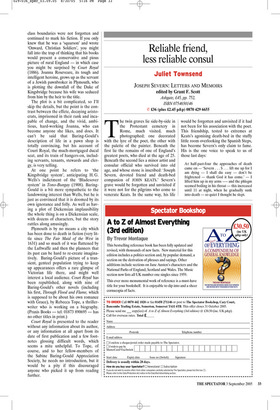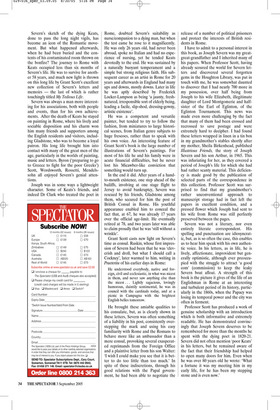Reliable friend, less reliable consul
Juliet Townsend
JOSEPH SEVERN: LETTERS AND MEMOIRS edited by Grant F. Scott Ashgate, £45, pp. 752, ISBN 0754650146 ✆ £36 (plus £2.45 p&p) 0870 429 6655 The twin graves lie side-by-side in the Protestant cemetery in Rome, much visited, much photographed; one decorated with the lyre of the poet, the other with the palette of the painter. Beneath the first lie the remains of one of England’s greatest poets, who died at the age of 25. Beneath the second lies a minor artist and consular official who survived into old age, and whose stone is inscribed: ‘Joseph Severn, devoted friend and death-bed companion of JOHN KEATS.’ Severn’s grave would be forgotten and unvisited if it were not for the pilgrims who come to venerate Keats. In the same way, his life would be forgotten and unvisited if it had not been for his association with the poet. This friendship, tested to extremes at Keats’s agonising death-bed in the stuffy little room overlooking the Spanish Steps, has become Severn’s only claim to fame. His is the one voice to speak to us of those last days:
At half-past-four the approaches of death came on — ‘Severn ... S ... lift me up for I am dying — I shall die easy — don’t be frightened — thank God it has come.’ — I lifted him up in my arms —– and the phlegm seemed boiling in his throat — this increased until 11 at night, when he gradually sunk into death — so quiet I thought he slept.
Severn’s sketch of the dying Keats, done to pass the long night vigils, has become an icon of the Romantic movement. But what happened afterwards, when he had been buried and the contents of his contaminated room thrown on the bonfire? The journey to Rome with Keats occupied less than six months of Severn’s life. He was to survive for another 58 years, and much new light is thrown on this long life by Grant Scott’s excellent new collection of Severn’s letters and memoirs — the last of which is rather touchingly titled My Tedious Life.
Severn was always a man more interesting for his associations, both with people and events, than for his own achievements. After the death of Keats he stayed on painting in Rome, where his lively and sociable disposition and his charm won him many friends and supporters among the English residents and visitors, including Gladstone, who was to become a loyal patron. His long life brought him into contact with many of the great men of the age, particularly in the worlds of painting, music and letters. Byron (‘preparing to go to Greece to fight for the poor Greeks’) Scott, Wordsworth, Rossetti, Mendelssohn all enjoyed Severn’s genial attentions.
Joseph was in some ways a lightweight character. Some of Keats’s friends, and indeed Dr Clark who treated the poet in Rome, doubted Severn’s suitability as nurse/companion to a dying man, but when the test came he rose to it magnificently. He was only 26 years old, had never been abroad, spoke no Italian and had no experience of nursing, yet he tended Keats devotedly to the end. He was sustained by a naturally buoyant temperament and a simple but strong religious faith. His subsequent career as an artist in Rome for 20 years and afterwards in England had many ups and downs, mostly downs. Later in life he was aptly described by Frederick Locker-Lampson as being ‘a jaunty, freshnatured, irresponsible sort of elderly being, leading a facile, slip-shod, dressing-gowny, artistic existence’.
He was a competent and versatile painter, but tended to try to follow the fashion, from miniatures to large historical scenes, from Italian genre subjects to huge frescoes, rather than to speak with his own voice. An interesting feature of Grant Scott’s book is the large number of illustrations of Severn’s paintings. For most of his life he and his family were in acute financial difficulties, but he never lost his Micawber-like conviction that something would turn up.
In the end it did. After years of a handto-mouth existence, one step ahead of the bailiffs, involving at one stage flight to Jersey to avoid bankruptcy, Severn was rescued by his friends, Gladstone among them, who secured for him the post of British Consul in Rome. His youthful appearance enabled him to conceal the fact that, at 67, he was already 17 years over the official age-limit. He eventually retired at 78, and two years later was able to claim proudly that he was ‘still without a wrinkle’.
Grant Scott casts new light on Severn’s time as consul. Ruskin, whose first impression of Severn had been that he was ‘cleverish and droll, but what I should call a Cockney’, later warmed to him, writing in Praeterita of his earlier days in Rome:
He understood everybody, native and foreign, civil and ecclesiastic, in what was nicest in them, and never saw anything else than the nicest ... Lightly sagacious, lovingly humorous, daintily sentimental, he was in council with the cardinals today, and at a picnic in Campagna with the brightest English belles tomorrow.
He brought these amiable qualities to his consulate, but, as is clearly shown in these letters, Severn was often something of a liability in his post, consistently overstepping the mark and using his easy familiarity with Rome and the Romans to behave more like an ambassador than a mere consul, provoking several exasperated reprimands from the Foreign Office and a plaintive letter from his son Walter: ‘I wish I could make you see that it is better to do too little than too much.’ In spite of these indiscretions, through his good relations with the Papal government, he had been able to negotiate the release of a number of political prisoners and protect the interests of British residents in Rome.
I have to admit to a personal interest in this book, as Joseph Severn was my greatgreat-grandfather and I inherited many of his papers. When Professor Scott, having already scoured the world for Severn letters and discovered several forgotten gems in the Houghton Library, was put in touch with me, he was somewhat daunted to discover that I had nearly 700 more in my possession, over half being from Joseph to his wife Elizabeth, illegitimate daughter of Lord Montgomerie and halfsister of the Earl of Eglinton, of the Eglinton Tournament. This news was made even more challenging by the fact that many of them had been crossed and recrossed to save postage and were extremely hard to decipher. I had found these letters wrapped in linen in a tin box in my grandmother’s stables shortly after my mother, Sheila Birkenhead, published Illustrious Friends, the story of Joseph Severn and his son Arthur, in 1965. This was infuriating for her, as they covered a period of Joseph’s life for which she had had rather scanty material. This deficiency is made good by the publication of selected parts of the correspondence in this collection. Professor Scott was surprised to find that my grandmother’s rather unconventional approach to manuscript storage had in fact left the papers in excellent condition, and a pressed flower which Joseph had sent to his wife from Rome was still perfectly preserved between the pages.
Severn was not a literary, nor even entirely literate correspondent. His spelling and punctuation are idiosyncratic, but, as is so often the case, this enables us to hear him speak with his own authentic voice. In his letters, as in life, he is lively, affectionate, improvident but generally optimistic, although ever preoccupied with the struggle to attract ‘a good com’ (commission) to keep the leaky Severn boat afloat. A strength of this book is the picture it gives of the life of an Englishman in Rome at an interesting and turbulent period of its history, particularly in the 1860s, when the Papacy was losing its temporal power and the city was often in ferment.
Professor Scott has produced a work of genuine scholarship with an introduction which is both informative and extremely readable. He has demonstrated convincingly that Joseph Severn deserves to be remembered for more than the months he spent with the dying poet in 1820-21. Severn did not often mention ‘poor Keats’ in his letters, but he remained aware of the fact that their friendship had helped to open many doors for him. Even when he was over 80 years old he wrote: ‘What a fortune it was my meeting him in my early life, for he has been my stepping stone and is even now.’










































 Previous page
Previous page